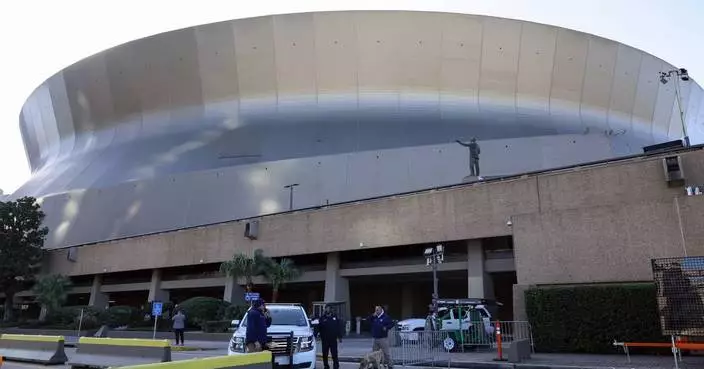INGLEWOOD, Calif. (AP) — The Los Angeles Clippers have a history of making things hard on themselves.
So why should trying to win for the first time at their new home be any different?
It took five attempts, but the Clippers finally broke Monday night through at Intuit Dome, overcoming a 26-point deficit in a 113-104 victory over the San Antonio Spurs.
"That’s the Clippers way. We can't do it the easy way, we always have to fight back and be dramatic but a win is a win," said center Ivica Zubac, who had 17 points and 13 rebounds.
Owner Steve Ballmer joked around with the players before the game that he thought his new $2 billion building was cursed and that he might have to tear it down and start over. While that did help lighten the mood, the Clippers knew that the pressure was building to break through.
“I'm just happy to get that off our chest. Now we can go out there and play free. I think we did it in the second half,” said James Harden, who had 17 points.
The Spurs led 40-14 at the end of the first quarter before the Clippers fought back. It was LA's largest comeback when trailing at the end of the first quarter, surpassing the 23-point deficit it had after 12 minutes at Boston on Feb. 9, 2019.
Amazing comebacks though have become a trademark during Tyronn Lue's five seasons as Clippers coach.
They trailed by 35 in the first half at Washington on Jan. 25, 2022, before winning 116-115. Last season they were also down by 26 to Cleveland in the third quarter before rallying for a 120-118 victory.
Monday's comeback tied the third-largest by the Clippers when trailing by any deficit since 1996, according to Sportradar.
“We've been playing good and hard at home, but just coming up short for four games. We just stuck with it,” Lue said.
The Clippers cut the margin down to eight at halftime and were within four going into the fourth quarter.
LA went on a 33-9 run during a nine-minute span late in the third quarter until the four-minute mark of the fourth to seize control.
It was the largest blown San Antonio lead at the end of the first quarter and the fourth-largest by any deficit in franchise history.
“That’s a very well-coached team with a lot of veterans that have played in a lot of high-level games. There's a lot of runs in games. I think we can learn about the attention to detail and the consistency of simple basketball,” said Spurs interim coach Mitch Johnson, who has taken over head coaching duties with Gregg Popovich sidelined indefinitely due to illness.
The Clippers next home game will also have increased attention. They host Philadelphia on Wednesday night after Paul George made his season debut on Monday night for the 76ers in a loss at Phoenix.
George played five seasons with the Clippers before signing with Philadelphia during the offseason.
“He was a great teammate, great friend. It’s going to be fun playing against him,” Zubac said.
AP NBA: https://apnews.com/hub/nba

Los Angeles Clippers guard Amir Coffey, left, dunks as San Antonio Spurs center Victor Wembanyama watches during the second half of an NBA basketball game, Monday, Nov. 4, 2024, in Inglewood, Calif. (AP Photo/Mark J. Terrill)

San Antonio Spurs forward Keldon Johnson, left, shoots as Los Angeles Clippers center Ivica Zubac defends during the second half of an NBA basketball game, Monday, Nov. 4, 2024, in Inglewood, Calif. (AP Photo/Mark J. Terrill)

Los Angeles Clippers guard Terance Mann, right, shoots as San Antonio Spurs center Victor Wembanyama, top, defends and center Ivica Zubac watches during the first half of an NBA basketball game, Monday, Nov. 4, 2024, in Inglewood, Calif. (AP Photo/Mark J. Terrill)

Los Angeles Clippers center Ivica Zubac, below, shoots as San Antonio Spurs center Victor Wembanyama defends during the first half of an NBA basketball game, Monday, Nov. 4, 2024, in Inglewood, Calif. (AP Photo/Mark J. Terrill)















